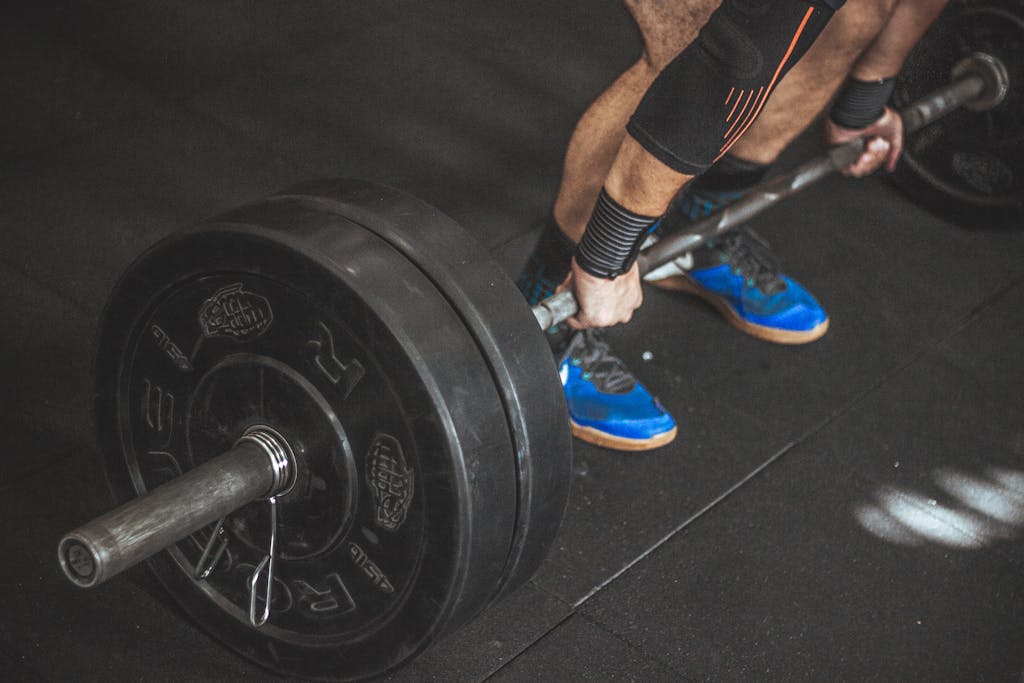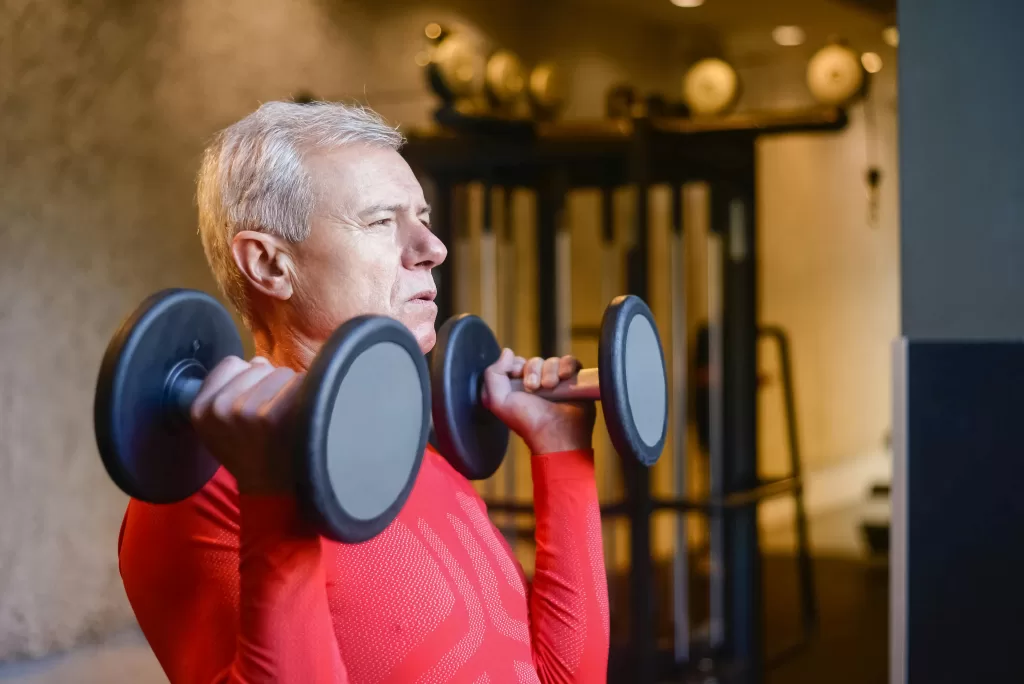The Powerful Link Between Muscle Mass and a Healthy Life
As we welcome in the new year we also welcome in new year’s resolutions. We invest in under-desk treadmills, choose stairs over elevators, and commit to a strict running schedule. While these efforts are respectable, research shows that true health isn’t achieved through cardio alone.
The cornerstone of long-term well-being lies in weightlifting, which focuses on building and maintaining muscle mass. Without this critical component, even the most determined fitness plans may fall short of supporting overall health.

Cardio vs Strength Training
The prevailing belief is that cardio is king. When people decide to increase their physical activity, their first step is often to invest in cardio equipment. Cardiovascular exercises, or endurance workouts, elevate your breathing and heart rate while burning calories more quickly than muscle-building exercises. However, the significant drawback of cardio is that its benefits largely cease once the workout ends.
Unlike cardio, the benefits of weight training extend well beyond the workout itself. After a weight training session, the body continues to burn calories at an elevated rate due to a process called excess post-exercise oxygen consumption (EPOC). Lifting weights puts positive stress on the body, which requires a period of healing and recovery that demands more energy than recovering from cardio1.
Studies have found that energy expenditure remains elevated for up to 24 hours following a weight training session, with the average increase lasting around 14 hours2. This effect occurs because weight training causes micro-tears in muscle and bone tissue that the body must repair. The repair process requires additional energy, resulting in a higher calorie burn even after the workout is complete.

Muscle Mass Plays a Crucial Role In:
Fat Loss
The primary goal of strength training is to build muscle. Lean muscle mass is metabolically active tissue2, meaning it requires more calories to maintain compared to fat. In fact, at rest, muscle burns more calories per kilogram than any other tissue in the body.
A 2020 systematic review found that resistance training resulting in increased muscle mass significantly boosts metabolic rate and burns more fat than cardio exercises alone3. In simple terms, muscle acts as a natural fat-burning machine. The more muscle you have, the more calories your body burns throughout the day, even when you’re not exercising.
Bone Health
Weight training is widely recognized for building muscle, but many people don’t realize it also strengthens bones. The resistance and stress applied during weight lifting create micro-tears in both muscle and bone tissue. The body responds to this stress by repairing and rebuilding4, leading to the development of stronger muscles and denser, more resilient bones.
A 2010 study found that 10.2 million adults in the United States over age 50 had osteoporosis, while an additional 43.4 million had reduced bone mass.5 Alarmingly, in today’s sedentary culture, early-onset osteoporosis (EOOP) is becoming increasingly common, with individuals as young as 20 being diagnosed. This condition significantly raises the risk of a lifetime of instability, falls, and fractures.

A study involving 948 men and women aged 40 to 59 found that those with higher lean muscle mass in their arms and legs also had significantly greater bone density in their lumbar spine.6 This is because exercises targeting arm and leg muscles often engage the back muscles and bones as stabilizers, leading to increased lumbar bone mass and overall spinal strength.
Delayed Biological Aging
Recent studies reveal that increased muscle mass plays a vital role in slowing biological aging. This form of aging occurs over time as damage accumulates in cells and tissues, driven by various stress factors such as lifestyle choices, poor nutrition, and chronic health conditions.
Muscle mass offers significant protection for the body. Greater muscle mass helps to prevent sarcopenia7 (the age-related decline in muscle function), maintain mobility and independence as we age, and significantly reduce the risk of metabolic diseases and their related comorbidities. By prioritizing strength training, individuals can preserve their health, enhance their quality of life, and potentially extend their longevity.
Cellular Regeneration
On a cellular level, muscle is just as powerful at the preservation and regeneration of new cells. Muscle tissue houses specialized cells known as satellite cells8, which function similarly to stem cells. These cells play a crucial role in repairing damaged muscle fibers. Physical activity activates satellite cells, prompting them to multiply and develop into new muscle fibers. This process helps combat the natural decline in muscle regeneration that occurs with aging.

Consistent muscle activity also stimulates protein synthesis, driving muscle growth and enhancing cellular function. This process is essential for maintaining healthy tissues, as regular protein turnover repairs and renews cells throughout the body9. Additionally, muscles release signaling molecules called myokines, which positively impact multiple tissues and systems. These myokines not only support overall health but may also play a key role in slowing the aging process, further highlighting the systemic benefits of maintaining active muscles.
Insulin Sensitivity
Skeletal muscle is the primary tissue where insulin stimulates glucose uptake. Muscle mass plays a vital role in regulating blood sugar levels by removing glucose (sugar and carbs) from the bloodstream and storing it as glycogen within muscle fibers. When insulin binds to receptors on muscle cells, it initiates a signaling cascade that causes glucose transporters (GLUT4) to move to the cell membrane, allowing glucose to enter the cell. Muscle contractions further enhance this process, increasing insulin sensitivity and improving glucose uptake.
In simple terms, muscle and insulin work together to lower blood glucose levels by removing excess glucose from the bloodstream. This process helps the body effectively use insulin and prevents it from becoming resistant to the hormone. Prolonged insulin resistance, if left unchecked, can lead to pre-diabetes and potentially progress to type 2 diabetes (T2DM).
Muscle Mass in the Presence of Obesity
A study10 of 132 overweight or obese adults aged 21–45 found that participants who were otherwise metabolically healthy (without type 2 diabetes, hypertension, or high cholesterol) demonstrated greater insulin sensitivity* if they had higher muscle mass, regardless of excess body fat. This suggests that even in the presence of overweight or obesity—both significant risk factors for type 2 diabetes—having higher muscle mass can help regulate insulin levels. Regulated insulin increases the body’s insulin sensitivity and reduces the risk of developing metabolic conditions such as type 2 diabetes, hypertension, and high cholesterol.

- *Insulin sensitivity refers to how effectively your body responds to insulin. High insulin sensitivity means your body efficiently uses insulin to regulate blood sugar levels, producing the appropriate amount needed. Conversely, low insulin sensitivity, or insulin resistance, indicates that your body struggles to use insulin properly, requiring higher amounts to maintain normal blood sugar levels. Over time, this resistance can lead to type 2 diabetes (T2DM) and other metabolic diseases.
Muscle Mass and a Healthy Life
Low muscle mass is associated with a multitude of health challenges, including reduced fat-burning capacity, difficulty losing weight, decreased bone density, insulin resistance that can lead to type 2 diabetes, and accelerated biological aging, ultimately shortening lifespan.
Building and maintaining muscle mass helps mitigate these challenges by enhancing metabolic health, improving bone strength, and supporting overall resilience. This not only promotes healthier aging but also reduces the cumulative impact of negative stressors on the body, fostering longevity and vitality.
Building muscle is a natural, nonpharmaceutical approach to achieving true health. If you’re new to weightlifting, it’s perfectly fine to start slow with light weights, gradually increasing as your body becomes stronger and more accustomed to the activity. The beauty of muscle mass is that even small gains can lead to significant health improvements. As you develop your weightlifting skills and build more muscle, the benefits to your overall health and well-being will continue to grow. Muscle mass is a cornerstone of a long, healthy, and independent life.
Supporting Research:
- MacKenzie-Shalders K, Kelly JT, So D, Coffey VG, Byrne NM. The effect of exercise interventions on resting metabolic rate: A systematic review and meta-analysis. J Sports Sci. 2020 Jul;38(14):1635-1649. doi: 10.1080/02640414.2020.1754716. Epub 2020 May 12. PMID: 32397898. ↩︎
- Slentz CA, Houmard JA, Kraus WE. Exercise, abdominal obesity, skeletal muscle, and metabolic risk: evidence for a dose response. Obesity (Silver Spring). 2009 Dec;17 Suppl 3(0 3):S27-33. doi: 10.1038/oby.2009.385. PMID: 19927142; PMCID: PMC3762482. ↩︎
- Miller, T., Mull, S., Aragon, A. A., Krieger, J., & Schoenfeld, B. J. (2018). Resistance Training Combined With Diet Decreases Body Fat While Preserving Lean Mass Independent of Resting Metabolic Rate: A Randomized Trial. International Journal of Sport Nutrition and Exercise Metabolism, 28(1), 46-54. Retrieved Jan 10, 2025, from https://doi.org/10.1123/ijsnem.2017-0221 ↩︎
- Human Health Co.(2024, March 25). Women and Strength Training: Will It Actually Make You “Look Like A Man?” humanhealthco.com/women-and-strength-training-will-it-actually-make-you-look-like-a-man. ↩︎
- Wright NC, Looker AC, Saag KG, et al. The recent prevalence of osteoporosis and low bone mass in the United States based on bone mineral density at the femoral neck or lumbar spine. J Bone Miner Res. 2014;29:2520–6. ↩︎
- Qin H, Jiao W. Correlation of muscle mass and bone mineral density in the NHANES US general population, 2017-2018. Medicine (Baltimore). 2022 Sep 30;101(39):e30735. doi: 10.1097/MD.0000000000030735. PMID: 36181112; PMCID: PMC9524880. ↩︎
- Pedersen BK. Which type of exercise keeps you young? Curr Opin Clin Nutr Metab Care. 2019 Mar;22(2):167-173. doi: 10.1097/MCO.0000000000000546. PMID: 30640736. ↩︎
- Carapeto PV, Aguayo-Mazzucato C. Effects of exercise on cellular and tissue aging. Aging (Albany NY). 2021 May 13;13(10):14522-14543. doi: 10.18632/aging.203051. Epub 2021 May 13. PMID: 34001677; PMCID: PMC8202894. ↩︎
- Chen XK, Yi ZN, Wong GT, Hasan KMM, Kwan JS, Ma AC, Chang RC. Is exercise a senolytic medicine? A systematic review. Aging Cell. 2021 Jan;20(1):e13294. doi: 10.1111/acel.13294. Epub 2020 Dec 30. PMID: 33378138; PMCID: PMC7811843. ↩︎
- Haines MS, Dichtel LE, Santoso K, Torriani M, Miller KK, Bredella MA. Association between muscle mass and insulin sensitivity independent of detrimental adipose depots in young adults with overweight/obesity. Int J Obes (Lond). 2020 Sep;44(9):1851-1858. doi: 10.1038/s41366-020-0590-y. Epub 2020 May 13. PMID: 32404950; PMCID: PMC7483278. ↩︎






